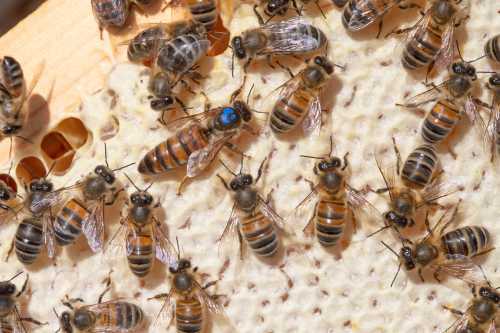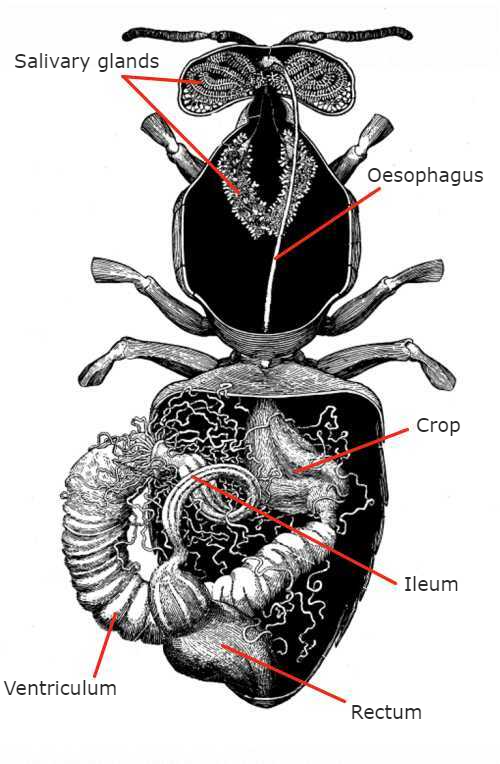Do Bees Have An Endocrine System?
The short
answer is: yes – bees do have an endocrine system.
Here we will take a look at the glands that make up the endocrine system, and the role of the endocrine system in bee development and functioning of the colony.
What Is The Endocrine System?
An endocrine gland is one that secretes hormones directly into the blood of an organism.
These hormones have physiological effects purely on the individual organism that secretes them. (In contrast, exocrine secretions, such as pheromones can have effects on organisms other than the organism that secretes them.)
Examples of endocrine hormones and glands in humans would include: growth hormone, secreted by the pituitary gland; insulin, secreted by the pancreas.
So an endocrine system consists of two parts:
- glands that secrete hormones directly into the blood of an organism; and
- the hormones (chemical messengers) that are secreted by the glands and that help regulate body functions.
But what about bees?
The endocrine system in bees
In the bee there is an endocrine system that is comprised of three endocrine glands:
- the prothoracic gland;
- the corpora allata; and
- the corpora cardiaca1.
These three glands secrete hormones directly into the blood of bees (the hemolymph).
The prothoracic gland
The
prothoracic gland is present only in larvae, and is not present in adult bees. It is a leaf-shaped structure that is situated between the first and second segments of the thorax.
The prothoracic gland produces a hormone called ecdysone that controls moulting (the shedding of
the hard exoskeleton in order to allow growth, known as ecdysis) in larvae and
pupae.
Hence ecdysis does not occur in adult bees, because adult insects are fully grown and do not moult2.
The corpora allata corpora cardiaca
The corpora allata corpora cardiaca are present in both adult bees and larvae.
They are connected to each other by nerve fibres, and to the brain by nerves and neurosecretory cells in the brain.
It is thought that the brain controls the activity of the corpora allata and corpora cardiaca through the nerve connections and by secretions from the neurosecretory cells.
The corpora allata
The corpora
allata produces a hormone called juvenile hormone that seems to have two
different functions: one function in larvae, and a different function in adults
(although both are effectively developmental).
In larvae and pupae, juvenile hormone controls growth and development; whereas in the adult bee, juvenile hormone is responsible for the change in workers’ roles as they age.
Queen honey bees have much larger corpora allata than worker honey bees.
In order to control growth and development, there is a variance in the levels of juvenile hormone and ecdysone. For example, the balance between these two hormones will decide whether a larva grows into a bigger larva or moves to the pupa stage of development.
The corpora cardiaca
The function
of the corpora cardiaca is not fully understood, but there is evidence that it
is in some way responsible for the differential maturation of queens and
workers - a process known as
‘caste-specific retardation’3.
How does the bee endocrine system affect bee development and functioning of the colony?
There are two biological functions being governed by the bee endocrine system:
- physical growth and development of individual bees;
- the development of bees’ roles within the colony.

Firstly, neurosecretory cells in the brain release brain hormone, which passes through the nervous connections into the corpora cardiaca, from where it is released directly into the bee hemolymph (see 'Do bees have a heart?').
The brain hormone causes the prothoracic gland
to release ecdysone, which initiates the process of ecdysis (molting – the
shedding of the bee’s harder exoskeleton, which allows physical growth)5.
The secretion of juvenile hormone by the corpora allata varies throughout the life of a bee, and is at its peak during larval development, but the peak levels found at this stage (usually around the time of the third and fourth larval molt – of six in total) are particularly pronounced in queens.
It is thought that it is this high juvenile hormone level that is responsible for the development of queens – most notably of some of the queen-specific organs, such as ovaries3.
It has also been shown that worker bees in queenless colonies have higher levels of juvenile hormone than worker bees in ‘queenright’ colonies6.
References:
1. Collinson C 2015 in Bee Culture – The Magazine
of American Beekeeping
2. Morse, R.A. and T. Hooper 1985. Moulting. In: The Illustrated
Encyclopedia Of Beekeeping. E.P. Dutton, New York, pp. 264-265.
3. Rachinsky, A. and K. Hartfelder 1990. Corpora allata
activity, a prime regulating element for caste-specific juvenile hormone titre
in honey bee larvae (Apis mellifera carnica). J. Insect Physiol. 36: 189-194.
4. Caron, D.M. and L.J. Connor 2013. Honey Bee Biology and
Beekeeping. Wicwas Press, Kalamazoo, MI, 368 pp.
5. Kaatz, H.H., H. Hildebrandt and W. Engels 1992. Primer effect
of queen pheromone on juvenile hormone biosynthesis in adult worker honey bees.
J. Comp. Physiol. B 162: 588-592.
If you found this page helpful or interesting, I'd really be grateful if you would share it with others - if not this page, perhaps another, such as Gardening For Bees.
Thank you so much :) .
